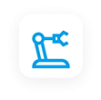The expansion of automation and data-driven decision-making has extended its reach far beyond the confines of controlled environments. A vast array of applications, ranging from environmental monitoring for scientific research to sewer inspection for waste management, rely heavily on sensor technology to gather crucial information from the ever-changing world around us.
However, unlike the controlled settings of laboratories or factories, the outdoors presents a unique challenge. Here, sensors must remain resilient against a multitude of environmental factors, including extreme temperatures, precipitation, UV exposure, and dust and debris. Failing to withstand these conditions can not only impact the quality of data collection but also affect the sensor lifespan.
However, there's a special class of sensors designed for such harsh conditions: outdoor-rated sensors. Also known as all-weather sensors, these specially engineered devices can operate optimally and collect data consistently, regardless of the environmental conditions around them.
Let's find out how these outdoor-rated sensors work, their underlying mechanisms, and why using them makes more sense for outdoor applications than using the standard ones designed to operate in a controlled environment.
What are Outdoor-Rated/All-Weather Sensors
Sensors today are more intelligent, efficient, accurate, and capable. But they are also susceptible to their surrounding elements. Any external influence can interfere with their functioning, thus affecting their reliability. However, outdoor-rated sensors have a different built quality.
These sensors are generally shielded in protective encasings made from durable materials for physical robustness. They are often integrated with wireless technologies to ensure reliable and efficient long-distance data transmission without physical contact. It also enhances their remote control and monitoring capabilities.
The design of outdoor-rated/all-weather sensors enables them to tolerate extreme temperatures, high humidity, prolonged sunlight exposure, and corrosion, making them suitable for diverse outdoor settings. They are engineered to function reliably even when subjected to extreme environmental conditions.
Furthermore, these sensors are highly compatible with various networks and devices, facilitating easy connections. Advanced power management systems ensure minimal power consumption, contributing to their longevity and efficiency.
Why are Outdoor-rated/All-weather Sensors Important
Understanding the significance of outdoor-rated/all-weather sensors is crucial, especially in challenging environments like industrial settings, manufacturing and logistics, mines, ports, farms, and waste management facilities.
Here’s how these outdoor-rated sensors find applications in different areas:
Smart Agricultural Practices
As agricultural practices increasingly rely on robotic systems, outdoor sensors are widely used in this area. For instance, outdoor-rated LiDAR sensors help farmers with real-time data for 3D elevation mapping, soil insight, and analysis, on-ground monitoring, and precision agriculture. Similarly, all-weather laser distance sensors help with outdoor measurement and are used in crop height identification, land leveling, seed-germination stimulation, and others.
Mining Industry
The mining industry relies on different types of sensors for automated operations and improved productivity. Like LED-based optical fiber sensors used in hot metal detection systems, safety laser scanners for enhanced operational safety, and LiDAR sensors used for area monitoring and spatial recognition. As mines are subjected to extremely harsh environmental conditions, they demand robust and durable sensors to withstand these challenges. Thus, outdoor-rated sensors are suitable for such applications as they exhibit high insulation, vibration, noise, and impact resistance.
Ports and Logistics
Modern sensor technologies have revolutionized ports and logistics operations, enhancing safety, reliability, and predictability. Laser sensors help with accurate cargo handling, container loading and unloading, safer navigation, and collision avoidance. These are all heavy-duty outdoor operations, so only tough sensors can function effectively in these settings. All-weather sensors are used in ports and terminals because they can function reliably even in rugged ambient conditions.
Waste Management
Smart waste management has become necessary, considering the massive increase in the volume of waste generated. Laser scanners, LiDAR, optical fibers, and other such advanced sensing solutions help in waste management processes like sorting, collection, segregation, and sewage inspection. These sensors are continuously exposed to dust, moisture, chemicals, and other contaminants. Therefore, outdoor-rated/all-weather sensors should be used in these cases for reliable and precise results.
Hokuyo Sensors are the Perfect Solution for Outside Applications
Hokuyo's LiDAR sensors and laser sensors are strategically designed to efficiently handle such extensive outdoor applications. Our sensors are housed in rugged enclosures with IP64, IP65, or IP67 ratings, ensuring long-term durability and protection against high levels of dust and water.
With advanced features such as multi-echo capabilities, heater functions, enhanced internal filtering, and versatile USB and ethernet interfaces, Hokuyo sensors are equipped to excel in challenging outdoor environments.
Explore our range of innovative sensing solutions for superior and reliable outdoor performance.

 Factory Automation
Factory Automation Logistics Automation
Logistics Automation Process Automation
Process Automation Crane Collision Avoidance
Crane Collision Avoidance LiDAR/Obstacle Detection
LiDAR/Obstacle Detection Safety Laser Scanners
Safety Laser Scanners Optical Data Transmission
Optical Data Transmission Hot Metal Detectors
Hot Metal Detectors Laser Distance Sensor
Laser Distance Sensor Blog
Blog Whitepapers
Whitepapers Case Studies
Case Studies Infographics
Infographics